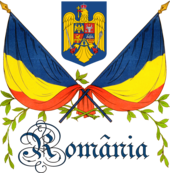This article has multiple issues. Please help improve it or discuss these issues on the talk page. (Learn how and when to remove these messages)
|
| This article is part of a series on |
| Symbols of Romania |
|---|
 |
This is a survey of the postage stamps and postal history of Romania.
Nineteenth century


The principality of Moldavia issued stamps immediately upon gaining autonomy in 1858, with the first cap de bour stamps being issued in July 1858. These were produced by hand stamping on laid paper, and are now quite rare. The initial round design was shortly followed by one using a square frame with rounded corners, and using blue or white wove paper. These are somewhat more common.
After the union of Moldavia and Wallachia in 1861, the design was adapted to show the emblems of both principalities side by side, and inscribed "FRANCO SCRISOREI". The first stamps inscribed "POSTA ROMANA" were issued in January 1865; the three values depicted Prince Alexandru Ioan Cuza in profile, facing right.
These did not last long in use, as Cuza was deposed the following year, and new stamps depicted Prince Carol I, also in profile, but facing left, and in a style very similar to contemporary French stamps. The adoption of the leu in 1867 required stamps in new denominations, which appeared in 1868.
In 1869, a new design consisted of the profile as before, but enclosed in an oval frame, a change lasting only until 1872, when the previous round frame once again came into use, with an overall design reminiscent of the contemporaneous stamps of France. They were originally printed in Paris, and then reprinted in Bucharest from 1876, the reprints having a rougher appearance and coarser perforations. New colors and values appeared in 1879.
In 1885, a new definitive series used larger and more readable numeric tablets, and surmounted Carol's profile with a bird. In 1889 the stamp paper was also impressed with a coat of arms, similar to, but not a true watermark. In 1891, Romania issued its first commemorative stamps, a series of five in which the usual profile of the king was framed by an inscription marking 25 years of his reign. The series of 1893 introduced a variety of frames, and the first stamps denominated in lei.


In 1891, Dimitrie C. Butculescu founded the Romanian Philatelic Society. He became its first president, running the society from his private house, and published The Official Gazette of the Romanian Philatelic Society.
In 1896, Romanian stamps were overprinted in Turkish currency for use on ships passing between Constanța and Constantinople.
In 1903, the first pictorial designs were issued to note the opening of a new post office in Bucharest, followed by a series of 10 designs in 1906, for the 40th anniversary of Carol's reign.
Twentieth century
| This section needs expansion. You can help by adding to it. (January 2012) |

During World War I, Romanian territory was occupied by Austria, Germany, and Bulgaria, each of which issued stamps for the occupied areas.
See also
- Poșta Română
- Postage stamps and postal history of Moldova
- Postage stamps and postal history of Transnistria
- Zimbrul și Vulturul
References
- Dimitrie C. Butculescu – 160 years since his birth. World Online Philatelic Agency.
Sources
- Stanley Gibbons Ltd: various catalogues
- Encyclopaedia of Postal Authorities
- Rossiter, Stuart & John Flower. The Stamp Atlas. London: Macdonald, 1986. ISBN 0-356-10862-7
Further reading
- Cârjan, Lazăr. Catalogul Timbrelor Poştale Româneşti. București: Enciclopedia RAO Vol. 1: 1858-1947 (2006) ISBN 973-717-076-8 330p.; Vol. 2: 1948-1989 (2008) 330p.; Vol. 3: 1990-2009 (2009) 190p.
- Dragomir, Kiriac and Aurel Syurpateanu. Catalogul Marcilor Postale Românsti: Part 1: Perioada clasica si moderna (1858–1927); Part 2: Perioada contemporana (1927–1974); Part 3: Marci de serviciu, Interguri postale, Posta locale, Posta Romana peste hotare, poste straine. Bucharest: The authors, 1974 623p.
- Florescu, Maria Ecaterina and Cornel Spineanu. Romanian Postage Stamps, 1948-1965. Bucharest: Meridiane Pub. House, 1966 232p.
- Micu, Iosif. Teme s̡i Subiecte Filatelice din Istoria României. Bucures̡ti : Albatros, 1980 237p.
- Tebeica, Val. Les Premiers Timbres-poste Roumains, 1858-1865. Bucharest: Méridiens éditions, 1962 212p.
External links
- Romaniastamps.com
- Romanian stamp gallery
- Romfilatelia
- Philatelical Museum
- Classic Romanian stamps at Stampslandia